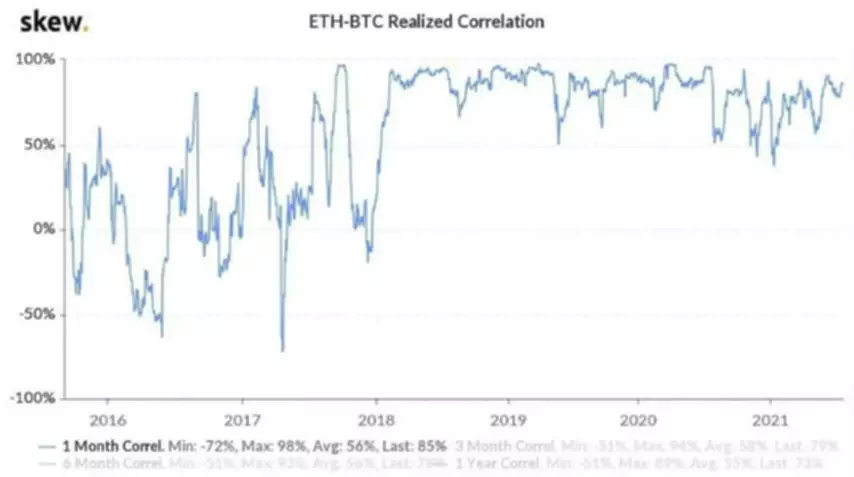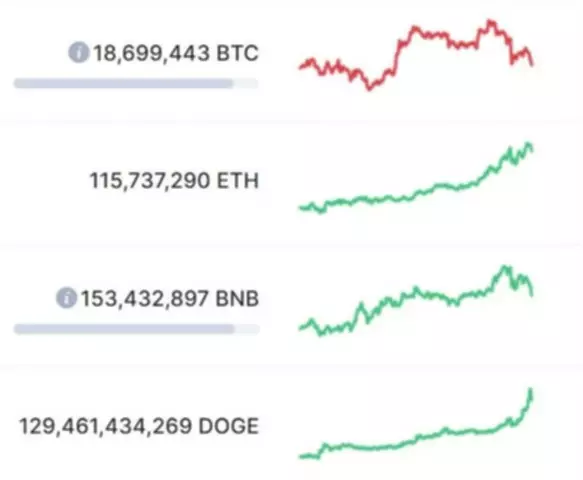August 13, 2021 |
James Messi
Bitcoin (BTC) as the world’s premier cryptocurrency, has always led the way for other altcoins. Where Bitcoin’s trend goes, other altcoins follow. This is especially true with Bitcoin and its closest rival, in terms of market capitalization, Ethereum. Since 2018, the two cryptocurrencies have been trading in tandem, with Ethereum predominantly in Bitcoin’s trail.
Despite the differences in the economics and general use of the two cryptocurrencies, Bitcoin and Ethereum have always tended to follow the same trends, whether up or down. Looking back at the recent history of the two digital currencies, one would see that they are highly correlated assets.
However, more recent developments have made analysts pause and consider whether the two leading cryptocurrencies are beginning to drift away from each other.
Before delving deeper, it would be a good idea to look separately at these two cryptocurrencies.
Bitcoin and Ethereum
Bitcoin, like other altcoins, operates on blockchain technology. What this means is that every transaction is collected and collated together by niners into a group, called a block. These blocks are then added together, creating what is called a blockchain. Blockchains act as a database or ledger, a permanent storage of any and all transactions that have been made using a given cryptocurrency.
The first of its kind, Bitcoin is presently the world’s top cryptocurrency. Similar to any other assets, Bitcoin, as well as other digital currencies, can be converted into cash. As of writing, the BTC to USD rate stands at a whopping 1 BTC = $40,897.15.
There is currently no official mechanism that is specific to Bitcoin for the BTC to USD exchange. Instead, various cryptocurrency exchanges online where people can make transactions exist. However, these transactions can also be done in person or over any communications platform, enabling even small businesses to accept Bitcoin.
In much the same way as its physical counterpart, digital currencies such as Bitcoin are created as a way for people to make financial deals over the internet. It is envisioned as a complementary payment system to the existing conventional modes.
Ranked second among the expansive list of existing cryptocurrencies, Ethereum, and its native token ether or ETH, is the closest competitor of Bitcoin.
Similar to Bitcoin, Ethereum runs on blockchain technology. It also shares similarity with its rival cryptocurrency in the way that it can be used to send and receive values worldwide without interference from any third party.
However, Ethereum also has certain differences. For one, while Bitcoin has been visualized as substitute to online banking and day-to-day transactions, Ethereum had been conceptualized with the end goal of replacing internet third-parties.
While helpful, Ethereum sees intermediaries as open to censorship and robs users of control over apps that use these third parties. This is what Ethereum seeks to remove and replace with smart contracts that automatically execute rules.
Aside from being able to function like Bitcoin in its being a medium of exchange or a store of value, Ethereum boasts the capability to allow its users to create applications that “run” on the cryptocurrency’s blockchain in the same way that software “runs” on a computer. This ensures that the applications developed on Ethereum’s blockchain are decentralized and that the creator of these applications does not have any control over the users’ data, true to Ethereum’s vision of giving control back to the users.
Despite being more functional than Bitcoin, Ethereum remains second in terms of value. As of writing, the BTC to ETH rate stands at 1 BTC = 14.76 ETH, while the ETH to USD rate is at 1 ETH = 2,754.64.
How Ethereum Became Correlated With Bitcoin
Being the highest valued cryptocurrency in the global market, the ebb and flow of Bitcoin’s value invariably affects the value of other altcoins. This is especially true with Ethereum, the altcoin with the highest correlation rate with Bitcoin. In fact, since the start of 2018, the correlation of the two digital currencies hasn’t dropped below 50%, as seen in the chart below.

One of the reasons why Ethereum, along with other altcoins, correlates with Bitcoin is because other altcoins are actually measured in Bitcoin, much like how the fiat currency of countries are measured against the US dollar.
Related to this, a large number of altcoins cannot be bought directly using fiat currencies. A buyer would first have to buy Bitcoin, and then trade the Bitcoin for the altcoin that they wanted. This relationship ties down the value of other altcoins to that of Bitcoin.
Another reason is investor sentiment towards Bitcoin. It is a fact that during the times when Bitcoin would dramatically rise or fall, other altcoins would follow suit. This can be attributed to investors’ trickle-down sentiment towards Bitcoin. When investors have a positive outlook for Bitcoin, this attitude is also applied to other altcoins. The same thing happens when Bitcoin’s prospects look dark.
Is Ethereum Decoupling From Bitcoin?
Despite the high correlation that Bitcoin and Ethereum have enjoyed in recent years, analysts are now speculating whether the two largest digital currencies are now going their separate ways.
One of the main reasons analysts are supporting the decoupling theory is Ethereum’s shift from proof-of-work to proof-of-stake, introduced in the Ethereum 2.0 update.
In a proof-of-work model, mining requires the work of a multitude of computers dedicated to solving highly complicated algorithmic puzzles in order to obtain the underlying cryptocurrency. This model requires an immense amount of energy to sustain and leaves a heavy toll on the environment. Ethereum, by shifting to a proof-of-stake model, has cut out the advanced cryptographic puzzles and thus dramatically decreased the environmental and monetary cost of mining.
Aside from this deviation from the energy-intensive mining process, Ethereum’s 2.0 update would also work on its scalability. At present, Ethereum can process about 15-45 transactions per second, but this is still not enough to handle all of the platform’s users worldwide. If properly executed, Ethereum 2.0 could potentially process up to 100,000 transactions per second.
This difference in the mining process, reduction in transaction fees, and processing speed is what some analysts believe could limit Ethereum’s correlation with Bitcoin.
However, others believe that the separation that Bitcoin is experiencing with Ethereum now is not really a decoupling, but just the hints of an “alt season.” An alt season is when altcoins such as Ethereum tend to outperform Bitcoin during periods of time when Bitcoin-related excitement is low.
Proponents of alt season arguments speculate that the recent lack of upside volatility of Bitcoin may have put off impatient traders.
Another support for alt season arguments is that while Ethereum’s movement veers away from Bitcoin’s, it remains in tandem with ther altcoins such as DOGE or BNB, casting doubts on the decoupling theory.

Whether Ethereum is indeed decoupling from Bitcoin, or it is just hinting at the start of an alt season, remains to be seen. What is certain, however, is that Ethereum is moving on a path that is separate from that of Bitcoin’s, and the final direction of this movement may only be seen once Ethereum’s 2.0 update has been fully rolled out.